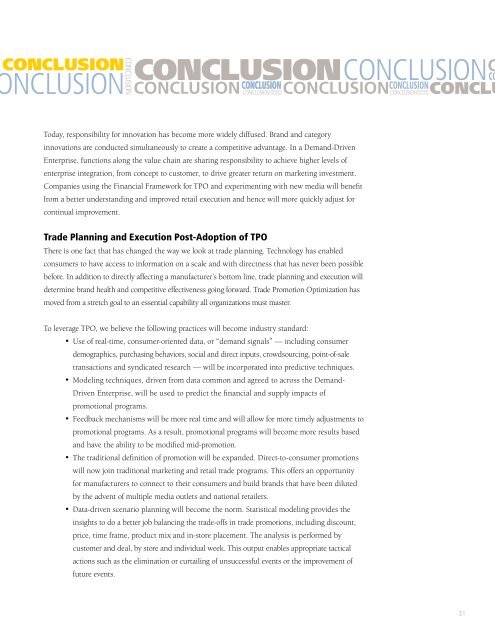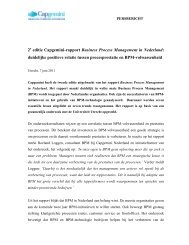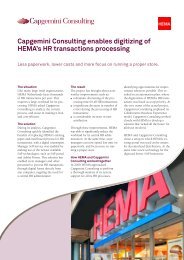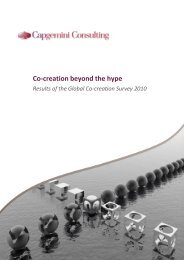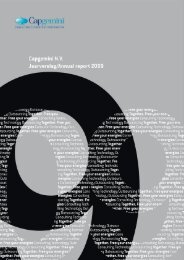ROI - Capgemini
ROI - Capgemini
ROI - Capgemini
Create successful ePaper yourself
Turn your PDF publications into a flip-book with our unique Google optimized e-Paper software.
conclusion<br />
NCLUSION<br />
CONCLUSION<br />
C<br />
CO<br />
conclu<br />
CONCLUSION CONCLUSION<br />
CONCLUSION<br />
CONCLUSION<br />
CONCLUSION<br />
CONCLUSION<br />
CONCLUSION<br />
CONCLUSION<br />
CONCLUSION CONCLUSION<br />
CONCLUSION CONCLUSION<br />
Today, responsibility for innovation has become more widely diffused. Brand and category<br />
innovations are conducted simultaneously to create a competitive advantage. In a Demand-Driven<br />
Enterprise, functions along the value chain are sharing responsibility to achieve higher levels of<br />
enterprise integration, from concept to customer, to drive greater return on marketing investment.<br />
Companies using the Financial Framework for TPO and experimenting with new media will benefit<br />
from a better understanding and improved retail execution and hence will more quickly adjust for<br />
continual improvement.<br />
Trade Planning and Execution Post-Adoption of TPO<br />
There is one fact that has changed the way we look at trade planning. Technology has enabled<br />
consumers to have access to information on a scale and with directness that has never been possible<br />
before. In addition to directly affecting a manufacturer’s bottom line, trade planning and execution will<br />
determine brand health and competitive effectiveness going forward. Trade Promotion Optimization has<br />
moved from a stretch goal to an essential capability all organizations must master.<br />
To leverage TPO, we believe the following practices will become industry standard:<br />
• Use of real-time, consumer-oriented data, or “demand signals” — including consumer<br />
demographics, purchasing behaviors, social and direct inputs, crowdsourcing, point-of-sale<br />
transactions and syndicated research — will be incorporated into predictive techniques.<br />
• Modeling techniques, driven from data common and agreed to across the Demand-<br />
Driven Enterprise, will be used to predict the financial and supply impacts of<br />
promotional programs.<br />
• Feedback mechanisms will be more real time and will allow for more timely adjustments to<br />
promotional programs. As a result, promotional programs will become more results based<br />
and have the ability to be modified mid-promotion.<br />
• The traditional definition of promotion will be expanded. Direct-to-consumer promotions<br />
will now join traditional marketing and retail trade programs. This offers an opportunity<br />
for manufacturers to connect to their consumers and build brands that have been diluted<br />
by the advent of multiple media outlets and national retailers.<br />
• Data-driven scenario planning will become the norm. Statistical modeling provides the<br />
insights to do a better job balancing the trade-offs in trade promotions, including discount,<br />
price, time frame, product mix and in-store placement. The analysis is performed by<br />
customer and deal, by store and individual week. This output enables appropriate tactical<br />
actions such as the elimination or curtailing of unsuccessful events or the improvement of<br />
future events.<br />
31


